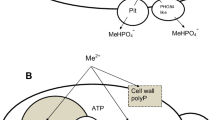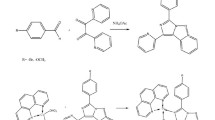Summary
Our studies on the mechanism of resistance of the murine leukemia L1210-PDD line tocis-dichlorodiammineplatinum(II) (cis-DDP) have not shown why it is 10-fold more resistant to the drug than the L1210 line. For this reason we investigated metallothionein-like proteins (‘MTs’) in these cells. Soluble protein extracts from cultures treated for 24 h withcis-DDP, zinc sulphate or saline were anaerobically eluted from columns of chemically reduced Sephadex G-75, and the profiles of zinc, copper and platinum were determined along with those for incorporated radioactive cyst(e)ien and tyrosine. Both salinetreated cell lines contained similar levels of ‘MTs’, which were induced by exposure to a minimally toxic level of zinc (100 μM). Zinc induction of ‘MTs’ was nearly 4-fold greater in L1210 than in L1210-PDD cells. The levels of mRNA for metallothionein I (MTI) and (MTII) in uninduced cells were measured by dot-blotting with a cDNA probe. The L1210-PDD cells contained 80% of the MTI and 41% of the MTII compared with L1210 cells, confirming the similar levels in uninduced cells. L1210-PDD cells were 2-fold more sensitive than L1210 cells to cadmium and equally sensitive to zinc. Thus, the resistance of L1210-PDD cells tocis-DDP was not associated with cross-resistance to group IIb metals, whereas their sensitivity to cadmium did reflect the relative inability of the cells to synthesize ‘MTs’. The L1210 cells produced ‘MTs’ when treated with 0.5 and 5.0 μM cis-DDP, but the L1210-DDP cells did not when treated with 5.0–40 μM cis-DDP. Small amounts of platinum (<21% of the total eluted) were bound to ‘MTs’ in both cell lines, but platinum provided a minor portion of the ‘MT’-bound metals, with zinc and copper contributing the bulk. The basis for the resistance of L1210-PDD cell tocis-DDP is neither an increased level of ‘MTs’ in the resistant cells nor an enhanced ability to increase the synthesis of ‘MTs’ after drug exposure.
Similar content being viewed by others
References
Alexander J, Forre O, Aaseth J, Dobloug J, Overbo S (1982) Induction of a metallothionein-like protein in human lymphocytes. Scand J Immunol 15:217
Arrich BA, Nathan CF (1984) Glutathione metabolism as a determinant of therapeutic efficacy. Cancer Res 44:4224
Bakka A, Endresen L, Johnsen ABS, Edminson PD, Rugstad HE (1981) Resistance againstcis-dichlorodiammineplatinum in cultured cells with a high content of metallothionein. Toxicol Appl Pharmacol 61:215
Bakka A, Johnsen AS, Endresen L, Rugstad HE (1982) Radio-resistance in cells with high content of metallothionein. Experientia 38:381
Basolo F, Pearson RG (1967). Mechanisms of inorganic reactions. A study of metal complexes in solution, 2nd edn. Wiley, New York
Batist G, Tulpules A, Sinha BK, Katki AG, Myers CE, Cowan KH (1986) Overexpression of a novel anionic glutathione transferase in multidrug-resistant human breast cancer cells. J Biol Chem 261:5544
Beach LR, Palmiter RD (1981) Amplification of the metalothionein-K gene in cadmium-resistant mouse cells. Proc Natl Acad Sci USA 78:2110
Bertino JR, Cadman ED, Weiner HL, Cashmore A, Moroson BA, Srimatkandada S, Schornagel JH, Medina WD, Dube SK (1983) Gene amplification and altered enzymes as mechanisms for the development of drug resistance. Cancer Treat Rep 67:901
Burchenal JH, Kalaher K, Dew KL, Gale G (1979) Studies of cross-resistance, synergistic combinations and blocking of activity of platinum derivatives. Biochimie 60:961
Cole WC, Wolf W (1980) Preparation and metabolism of a cisplatin/serum protein complex. Chem-Biol Interact 30:223
Davis LG, Dibner MD, Battey JF (1986) Basic methods in molecular biology, ch 11-1. p 130, Elsevier, New York
Domin BA, Grill SP, Cheng Y (1983) Establishment of dihydrofolate reductase-increased human cell lines and relationship between dihydrofolate reductase levels and gene copy. Cancer Res 43:2155
Durnam DM, Palmiter RD (1984) Induction of metallothionein-I mRNA in cultured cells by heavy metals and iodoacetate: evidence for gratuitous inducers. Mol Cell Biol 4:484
Eastman A, Illenye S (1984) Murine leukemia L1210 cell lines with different patterns of resistance to platinum coordination complexes. Cancer Treat Rep 68:1189
Endresen L, Bakka A, Rugstad HE (1983) Increased resistance to chlorambucil in cultured cells with a high concentration of cytoplasmic metallothionein. Cancer Res 43:2918
Evans RM, Patierno SR, Wang D-S, Cantoni O, Costa M (1983) Growth inhibition and metallothionein induction in cadmium-resistant cells by essential and non-essential metals. Mol Pharmacol 24:77
Farnworth PG, Hillcoat BL, Roos IAG (1989) Metallothionein induction in mouse tissues bycis-dichlorodiammineplatinum(II) and its hydrolysis products. Chem Biol Interact 69:319
Feinberg A, Vogelstein B (1983) A technique for radiolabelling DNA restriction endonuclease fragments to high specific activity. Anal Biochem 132:6
Feinberg A, Vogelstein B (1984) Addendum: a technique for radiolabelling DNA restriction endonuclease fragments to a high specific activity. Anal Biochem 137:266
Gick GG, McCarty KS Sr (1982) Amplification of the metallothionein-I gene in cadmium- and zinc-resistant Chinese hamster ovary cells. J Biol Chem 257:9049
Glennas A, Bakka A, Rugstad HE (1983) Cultured human cells with a high content of metallothionein show resistance against gold chloride. Scand J Rheumatol 12:321
Goering PL, Klaassen CD (1984) Zinc-induced tolerance to cadmium hepatotoxicity. Toxicol Appl Pharmacol 74:299
Hayashi K, Fujiki H, Sugimura T (1983) Effects of tumor promoters on the frequency of metallothionein I gene amplification in cells exposed to cadmium. Cancer Res 43:5433
Hildebrand CE, Cram LS (1979) Distribution of cadmium in human blood cultured in low levels of CdCl2: accumulation of Cd in lymphocytes and preferential binding to metallothionein. Proc Soc Exp Biol Med 161:438
Hildebrand CE, Tobey RA, Campbell EW, Enger MD (1979) A cadmium-resistant variant of the Chinese hamster (CHO) cell with increased metallothionein induction capacity. Exp Cell Res 124:237
Hildebrand CE, Griffith JK, Tobey RA, Walters RA, Enger MD (1981) Morecular mechanisms of Cd detoxification in Cd-resistant cultured cells: role of metallothionein and other inducible factors. In: The biological role of metallothionein. Elsevier, Amsterdam, p 279
Howe-Grant ME, Lippard SJ (1980) Aqueous platinum(II) chemistry; binding to biological molecules. Metal Ions Biol Systems 11:63
Instruction manual (1987) Zeta-probe blotting membrane. Biorad, California.
Kagi JHR, Nordberg M (1979) Metallothionein. Experientia Supplement 34. Birkhäuser, Basel
Karin M, Andersen RD, Herschman HR (1980) Induction of metallothionein mRNA in HeLa cells by dexamethasone and by heavy metals. Eur J Biochem 118:527
Karin M, Haslinger A, Holtgreve H, Richards RI, Krauter P, Westphal HM, Bento M (1984) Characterization of DNA sequences through which cadmium and glucocorticoid hormones induce human metallothionein-IIA gene. Nature 308:513
Kobayashi S, Kimura M (1980) Different inducibility of metallothionein in various mammalian cells in vitro. Toxicol Lett 5:357
Kraker A, Schmidt J, Krezoski S, Petering DH (1985) Binding ofcis-dichlorodiammineplatinum(II) to metallothionein in Ehrlich cells. Biochem Biophys Res Commun 130:786
Litterst CL (1984) Cisplatinum: a review, with special reference to cellular and molecular interactions. Agents Actions 15:520
Lonnerdal B (1980) Chemical modification of dextran gels for gel filtration of trace element ligands. In: Trace element analytical chemistry in medicine and biology. Walter de Gruyter, Berlin, p 439
Martin RB (1983) Hydrolytic equilibria and N7 versus N1 binding in purine nucleosides ofcis-diamminedichloroplatinum(II). Palladium(II) as a guide to platinum(II) reactions at equilibrium. In: Lippard SJ (ed) Platinum, gold, and other metal chemotherapeutic agents. American Chemical Society, Washington, DC (ACS Symposium Series 209, p 231)
Mason R, Edwards IR, McLaren SJ (1984) Interaction of platinum with metallothionein-like ligands in the rat kidney after administration ofcis-dichlorodiammineplatinum(II). Chem Biol Interact 49:165
Murphy MP, Andrews PA, Howell SB (1985) Metallothionein mediated cisplatin and melphalan resistance in human ovarian carcinoma [Abstract 1357]. Proc Am Assoc Cancer 26:344
Naganuma A, Satoh M, Koyama Y, Imura N (1985) Protective effect of metallothionein inducing metals on lethal toxicity ofcis-diamminedichloroplatinum in mice. Toxicol Lett 24: 203
Panemangalore M, Brady FO (1978) Induction and synthesis of metallothionein in isolated perfused rat liver. J Biol Chem 253:7898
Riordan JR, Ling V (1986) Genetic and biochemical characterization of multidrug resistance. In: Membrane transport of antineoplastic agents. Pergamon, Oxford, p 215
Roberts JJ, Pera MF Jr (1983) DNA as a target for anticancer coordination compounds. In: Lippard SJ (ed) Platinum, gold, and other metal chemotherapeutic agents. American Chemical Society, Washington, DC (ACS Symposium Series 209, p 3)
Schimke RT, Beverley S, Brown P, Cassin R, Federspiel N, Gasser C, Hill A, Johnston R, Marian B, Masse E, Rath H, Smouse D, Ilsty T (1984) Gene amplification and drug resistance in cultured animal cells. Cancer Treat Rev 11 [Suppl A]:9
Sharma RP, Edwards IR (1983)cis-Platinum: subcellular distribution and binding to cytosolic ligands. Biochem Pharmacol 32:2665
Shworak NW, Snyder FF, Gedamu L (1983) Identification of a cadmium-binding protein from a cadmium-resistant variant of human lymphoblastoid cells (WI-L2). Biochim Biophys Acta 763:332
Sirotnak FM (1986) Correlates of folate analog transport. pharmacokinetics and selective antitumor action. In: Membrane transport of antineoplastic agents. Pergamon, Oxford, p 241
Stone F (1989) Studies on the resistance of murine leukemia cells to cisplatinum. PhD Thesis, submitted to the University of Melbourne
Zelazowski AJ, Garvey JS, Hoeschele JD (1984) In vivo and in vitro binding of platinum to metallothionein. Arch Biochem Biophys 229:246
Author information
Authors and Affiliations
Additional information
This work was funded from a Peter Crimmins Research Fellowship held by P. G. F.
Rights and permissions
About this article
Cite this article
Farnworth, P., Hillcoat, B. & Roos, I. Metallothionein-like proteins and cell resistance tocis-dichlorodiammineplatinum(II) in L1210 cells. Cancer Chemother. Pharmacol. 25, 411–417 (1990). https://doi.org/10.1007/BF00686051
Received:
Accepted:
Issue Date:
DOI: https://doi.org/10.1007/BF00686051




